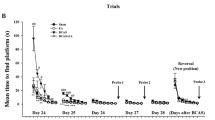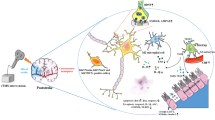Abstract
tDCS, a new, safe, non-invasive physical therapy method, is often used in motor dysfunction rehabilitation. However, the effects and underlying mechanisms of tDCS on hippocampal neurogenesis after cerebral ischemia (CI) are still unclear. This study aimed to investigate the promotive effect and mechanism of repetitive anodal-tDCS on hippocampal neurogenesis after CI in mice. The CI model in mice was established using bilateral common carotid artery occlusion (BCCAO). The pathological changes in the hippocampal CA1 region and cognitive function were assessed by hematoxylin and eosin staining and Morris water maze test, respectively. Hippocampal neurogenesis was observed by immunofluorescence staining. The levels of expression of ephrinb1, EPHB2, MAP-2, and NMDAR in the hippocampi were analyzed by qRT-PCR and Western blotting. Compared with the sham mice, the model mice showed significant neuronal damage in the hippocampal CA1 region (P < 0.01), cognitive dysfunction (P < 0.01), and endogenous hippocampal neurogenesis (P < 0.01). These results suggested that the CI model was successfully established, and that CI could promote endogenous hippocampal neurogenesis, but this hippocampal neurogenesis was unable to recover cognitive dysfunction. Compared with the model mice, the tDCS mice had ameliorated pathological damage in the CA1 region (P < 0.01), improved cognitive function (P < 0.01), increased hippocampal neurogenesis (P < 0.01), and increased mRNA and protein expression of ephrinb1, EPHB2, MAP-2, and NMDAR (P < 0.05). Repetitive anodal-tDCS can promote hippocampal neurogenesis and improve cognitive function in CI mice. The effect may be related to the activation of the ephrinb1/EPHB2/MAP-2/NMDAR signaling pathway.





Similar content being viewed by others
Abbreviations
- BCCAO:
-
Bilateral common carotid artery occlusion
- BrdU:
-
5-Bromo-2′-deoxyuridine
- CI:
-
Cerebral ischemia
- DCX:
-
Doublecortin
- DG:
-
Dentate gyrus
- Eph:
-
Erythropoietin-producing hepatocellular
- H&E:
-
Hematoxylin and eosin
- MAP-2:
-
Microtubule-associated protein 2
- MWM:
-
Morris water maze
- NMDA:
-
N-Methyl-d-aspartic acid
- NSC:
-
Neural stem cells
- SVZ:
-
Subventricular zone
- tDCS:
-
Transcranial direct current stimulation
- TMS:
-
Transcranial magnetic stimulation
References
Belopasova, A. V., Dobrynina, L. A., Kadykov, A. S., Berdnikovich, E. S., & Tsypushtanova, M. M. (2020). Noninvasive brain stimulation in the rehabilitation of patients with post-stroke aphasia. Zhurnal Nevrologii i Psikhiatrii Imeni S.S. Korsakova, 120, 23–28.
Brittain, J. S., & Cagnan, H. (2018). Recent trends in the use of electrical neuromodulation in Parkinson’s disease. Current Behavioral Neuroscience Reports, 5, 170–178.
Chen, L., Song, D., Chen, B., Yang, X., & Cheng, O. (2020). Activation of liver X receptor promotes hippocampal neurogenesis and improves long-term cognitive function recovery in acute cerebral ischemia-reperfusion mice. Journal of Neurochemistry, 154, 205–217.
Chumley, M. J., Catchpole, T., Silvany, R. E., Kernie, S. G., & Henkemeyer, M. (2007). EphB receptors regulate stem/progenitor cell proliferation, migration, and polarity during hippocampal neurogenesis. Journal of Neuroscience, 27, 13481–13490.
Dundas, J. E., Thickbroom, G. W., & Mastaglia, F. L. (2007). Perception of comfort during transcranial DC stimulation: Effect of NaCl solution concentration applied to sponge electrodes. Clinical Neurophysiology, 118, 1166–1170.
Farzanehfar, P. (2018). Comparative review of adult midbrain and striatum neurogenesis with classical neurogenesis. Neuroscience Research, 134, 1–9.
Gong, J., Körner, R., Gaitanos, L., & Klein, R. (2016). Exosomes mediate cell contact-independent ephrin-Eph signaling during axon guidance. Journal of Cell Biology, 214, 35–44.
Hanamura, K., Washburn, H. R., Sheffler-Collins, S. I., Xia, N. L., Henderson, N., & Tillu, D. V. (2017). Extracellular phosphorylation of a receptor tyrosine kinase controls synaptic localization of NMDA receptors and regulates pathological pain. PLoS Biology, 15, e2002457.
Heit, J. J., & Wintermark, M. (2018). New developments in clinical ischemic stroke prevention and treatment and their imaging implications. Journal of Cerebral Blood Flow and Metabolism, 38, 1533–1550.
Huan, X., Oumei, C., Hongmei, Q., Junxia, Y., Xiaojiao, M., & Qingsong, J. (2020). PDE9 inhibition promotes proliferation of neural stem cells via cGMP-PKG pathway following oxygen-glucose deprivation/reoxygenation injury in vitro. Neurochemistry International, 133, 104630.
Lefaucheur, J. P., Antal, A., Ayache, S. S., Benninger, D. H., Brunelin, J., & Cogiamanian, F. (2016). Evidence-based guidelines on the therapeutic use of transcranial direct current stimulation (tDCS). Clinical Neurophysiology, 128, 56–92.
Liu, C. S., Rau, A., Gallagher, D., Rajji, T. K., Lanctôt, K. L., & Herrmann, N. (2017). Using transcranial direct current stimulation to treat symptoms in mild cognitive impairment and Alzheimer’s disease. Neurodegenerative Disease Management, 7, 317–329.
Maekawa, M., Namba, T., Suzuki, E., Yuasa, S., Kohsaka, S., & Uchino, S. (2009). NMDA receptor antagonist memantine promotes cell proliferation and production of mature granule neurons in the adult hippocampus. Neuroscience Research, 63, 259–266.
Monai, H., & Hirase, H. (2016). Astrocytic calcium activation in a mouse model of tDCS-Extended discussion. Neurogenesis (Austin), 3, e1240055.
Mortensen, J., Figlewski, K., & Andersen, H. (2016). Combined transcranial direct current stimulation and home-based occupational therapy for upper limb motor impairment following intracerebral hemorrhage: A double-blind randomized controlled trial. Disability and Rehabilitation, 38, 637–643.
Nolt, M. J., Lin, Y., Hruska, M., Murphy, J., Sheffler-Colins, S. I., & Kayser, M. S. (2011). EphB controls NMDA receptor function and synaptic targeting in a subunit-specific manner. Journal of Neuroscience, 31, 5353–5364.
Pikhovych, A., Stolberg, N. P., & Jessica, F. L. (2016). Transcranial direct current stimulation modulates neurogenesis and microglia activation in the mouse brain. Stem Cells International. https://doi.org/10.1155/2016/2715196.
Klein, R. (2012). Eph/ephrin signalling during development. Development, 139, 4105–4109.
Ramírez, E., Mendieta, L., Flores, G., & Limón, I. D. (2016). Neurogenesis and morphological-neural alterations closely related to amyloid β-peptide (25–35)-induced memory impairment in male rats. Neuropeptides, 67, 9–19.
Razza, L. B., Palumbo, P., Moffa, A. H., Carvalho, A. F., Solmi, M., & Loo, C. K. (2020). A systematic review and meta-analysis on the effects of transcranial direct current stimulation in depressive episodes. Depression and Anxiety. https://doi.org/10.1002/da.23004.
Sánchez-Farías, N., & Candal, E. (2015). Doublecortin is widely expressed in the developing and adult retina of sharks. Experimental Eye Research, 134, 90–100.
Sánchez, C., Díaz-Nido, J., & Avila, J. (2000). Phosphorylation of microtubule-associated protein 2 (MAP2) and its relevance for the regulation of the neuronal cytoskeleton function. Progress in Neurobiology, 61, 133–168.
Shi, X. D., Sun, K., Hu, R., Liu, X. Y., Hu, Q. M., & Sun, X. Y. (2016). Blocking the interaction between ephb2 and addls by a small peptide rescues impaired synaptic plasticity and memory deficits in a mouse model of Alzheimer’s disease. Journal of Neuroscience, 2016(36), 11959–11973.
Tian, L., Nie, H., Zhang, Y., Chen, Y., Peng, Z., & Cai, M. (2014). Recombinant humain-1 promotes neurogenesis and facilitates cognitive recovery following cerebral ischemia in mice. Neuropharmacology, 77, 453–464.
Toda, T., & Gage, F. H. (2018). Review: Adult neurogenesis contributes to hippocampal plasticity. Cell and Tissue Research, 373, 693–709.
Wegner, F., Kraft, R., Busse, K., Schaarschmidt, G., Wolfgang, H., & Schwarz, S. C. (2010). Glutamate receptor properties of human mesencephalic neural progenitor cells: NMDA enhances dopaminergic neurogenesis in vitro. Journal of Neurochemistry, 111, 204–216.
Wei, L., Ren, Q., Zhang, Y., & Wang, J. (2017). Effects of hyperbaric oxygen and nerve growth factor on the long-term neural behavior of neonatal rats with hypoxic ischemic brain damage. Acta Cirúrgica Brasileira, 32, 270–279.
Yu, X., Li, Y., Wen, H., Zhang, Y., & Tian, X. (2015). Intensity-dependent effects of repetitive anodal transcranial direct current stimulation on learning and memory in a rat model of Alzheimer’s disease. Neurobiology of Learning and Memory, 123, 168–178.
Zhen, G., & Doré, S. (2007). Optimized protocol to reduce variable outcomes for the bilateral common carotid artery occlusion model in mice. Journal of Neuroscience Methods, 166, 73–80.
Funding
This study was supported by the National Natural Science Foundation of China The authors disclosed receipt of the following financial support for the research, authorship, and/or publication of this article: This work was supported by grants from the National Natural Science Foundation of China (Nos. 81871002, 81471334, 81100981), Pharmacy College of Chongqing Medical University (Nos. YXY2019SDTR01), and the Natural Science Foundation of Chongqing (No. cstc2017jcyjAX0211).
Author information
Authors and Affiliations
Contributions
HMQ, OMC and QSJ conceived and designed the experiment. XJM and HX performed the experiments. XJM, HX, and JXY analyzed the data. XJM and HMQ wrote the manuscript.
Corresponding author
Ethics declarations
Conflict of interest
The authors declare that they have no conflict of interest.
Additional information
Publisher's Note
Springer Nature remains neutral with regard to jurisdictional claims in published maps and institutional affiliations.
Rights and permissions
About this article
Cite this article
Ma, X., Cheng, O., Jiang, Q. et al. Activation of ephrinb1/EPHB2/MAP-2/NMDAR Mediates Hippocampal Neurogenesis Promoted by Transcranial Direct Current Stimulation in Cerebral-Ischemic Mice. Neuromol Med 23, 521–530 (2021). https://doi.org/10.1007/s12017-021-08654-2
Received:
Accepted:
Published:
Issue Date:
DOI: https://doi.org/10.1007/s12017-021-08654-2




